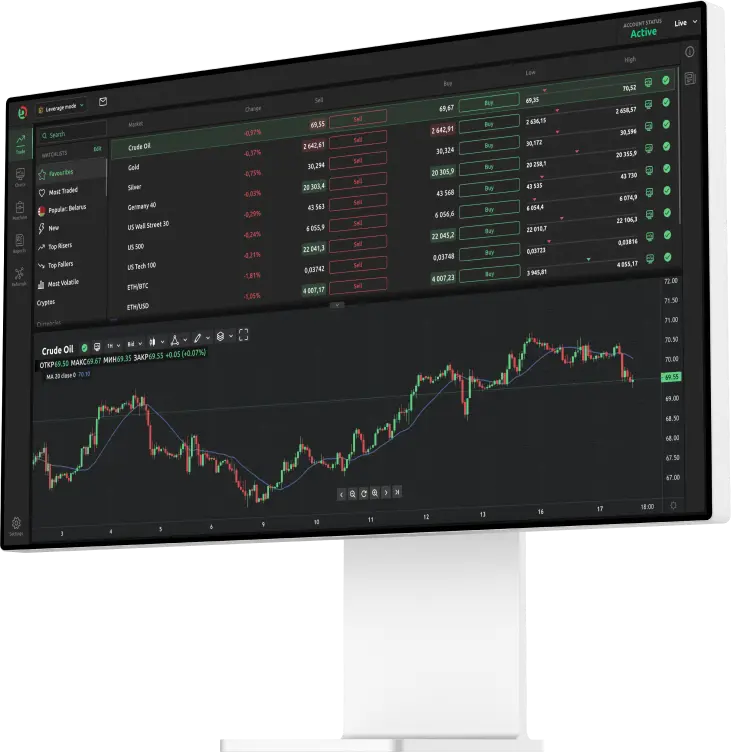A plan will help you take control of your trading and navigate your way to profitability

There is one simple difference between making money and losing money when trading – and that is having a solid plan in place.
A trading plan is your road map, which will enable you to navigate your way to profitability. If you take a wrong turn, you will be able to get back on track, before your losses run away with you.
Of course, there are other external factors beyond our control when trading, which can cause sudden changes in market trends, such as government policies, international trade, and supply and demand. However, by having a comprehensive plan in place, you will be better equipped to cope with these changes and make decisions based on objective analysis, rather than being influenced by your trading biases.
Why have a trading plan?
Essentially, a trading plan enables you to control the only thing you can control when trading. That is yourself.
Instilling discipline into your trading will help you reduce stress, prevent irrational behaviour, monitor your performance, identify problems, and make any necessary corrections.
Conversely, a plan will also enable you to trade more bravely, and push yourself outside your comfort zone. How many times have you let a loss run and cut a profit short because it was the comfortable thing to do? A plan will help to prevent this from happening and help reduce your number of bad trades.
How to make a trading plan
No two trading plans are the same, because no two traders are the same. So creating a plan is a very personal thing.It should reflect your trading style, psychology, biases and goals.
However, there are a few, key steps we can all take to develop a winning trading strategy.
Assess your skill
Even a rock solid plan can’t save you, if you don’t know what you’re doing. So stage one of your plan should be to assess your skills and test your strategy. Ask yourself:
- What is your trading experience?
- Do you feel confident in your understanding of the market?
- Are you able to make snap trading decisions?
- Have you tested your strategy?
- Are you confident your strategy will work?
If you answer 'no' to any of these questions, it’s a good idea to practice your plan before implementing it. Paper trading is a great idea, which is where you can practice buying and selling securities without risking real money. You can then make necessary adjustments to your plan, and ensure you go into battle fully prepared and fighting fit.
Mental preparation
Speaking of fitness, your mental health is imperative when making investment decisions. Trading can be very stressful, so you need to make sure you are up to the task ahead. If you’re having a bad day, don’t trade. You need a positive mental attitude (PMA) to ensure you make rational judgements and decisions.
Do whatever it takes to start the day with a PMA. Whether that means waking up earlier to allow time to prepare for the day ahead, going for a run, or having a decent breakfast. Find out what works for you and make it part of your trading routine.
Brett Steenbarger, author of The Psychology of Trading, recommends meditation, exercise or self-hypnosis to enhance your focus and help you get “in the zone” when trading.
“These methods don't eliminate emotion; they build minds,” he says. “If we can exercise for 30 minutes a day and build our cardiac fitness and our physiques, maybe – just maybe – a similar commitment could strengthen our abilities to operate within life's zone”.
Do your research
Knowledge is power, so before the market opens check what is going on around the world. Index futures are a good gauge, as future contracts trade 24-7. You should also look at overseas markets. Are they up or down?
The economic calendar is a trader’s best friend. It shows the scheduled news events or data releases related to the economy and financial markets, and will help you stay ahead of all market-moving events. By checking your economic calendar each morning you can note the times of any major data releases. It is generally better to wait until the report has been issued, rather than taking unnecessary trading risks during volatile reactions to the news.
Set clear goals
Another thing on your checklist should be to set yourself weekly, monthly and yearly goals, with realistic risk/reward ratios and profit targets. The risk/reward ratio is used by traders to manage their capital and risk of loss during trading. According to many market strategists, the ideal risk/reward ratio for investments is around 1:3, which means you shouldn’t trade unless the potential profit is at least three times greater than the risk. More on this below.
Decide your risk level
The amount you are prepared to risk on one trade depends on your trading style and tolerance for risk. However, professional traders tend to risk 1%-5% of their portfolio. You need to set a risk level that you’re comfortable with, and then have the discipline to stick to your plan and move out of the market when necessary.
Set entry and exit rules
One of the reasons computers are better at trading than people is that they don’t let emotions get in their way. If the market conditions are met, they will enter or exit. While you can’t deny your human nature, setting entry and exit rules can help you manage your emotional response.
“Your plan should clearly state the rules of entering, exiting and risk management, with as many different scenarios as possible," says Eketarina Serikova, Dzengi.com’s trade behaviour analyst.
“For example, what you will do if the market reaches the support/resistance line or a previous high or low? What will happen in case of surprise breaking news when you’re in the position?”
Your plan should state clear rules for entering the market. Write down what the indicators need to be doing, what the pricing action needs to be doing, and what is happening on the different time frames, in order for you to start trading.
Knowing when to exit a trade is just as important. Maybe even more so. You need to learn to accept losses and be prepared to exit the trade at your pre-determined target. Setting a stop loss order is a good way to ensure you exit at the right time for your plan and portfolio. The other way to exit a trade is with a profit target, which is a pre-determined price level, where you will close the trade.
Keep it on record
Keeping a record of your trading performance will help you analyse your strategy. If things start to go bearish, it can highlight where you’ve gone wrong, so you don't repeat unnecessary mistakes. Similarly, it can also help you identify why and how you won a trade.
Key information to record is:
- Entry price
- Exit price
- Original stop loss and take profit levels
- Position size
- Profit or loss
- A screenshot of the chart at the time of entry and exit
- Keep a trading journal
This is different to keeping records of data, which just show profit and loss. A journal is where you write comments on why you entered the trade and how you feel every time you open or close a position. This will help you analyse your performance and improve your trading.
“It can be hard to notice these emotions as they are happening – we get caught up in the moment,” says Serikova. “But once you get used to reviewing and analysing how you feel, you will become much more proficient at being able to spot the impact your emotions are having on your behaviour.”
You should never underestimate the power of planning. Knowing how to create a trading plan won’t guarantee profits, but it will help you trade more consistently and successfully.

